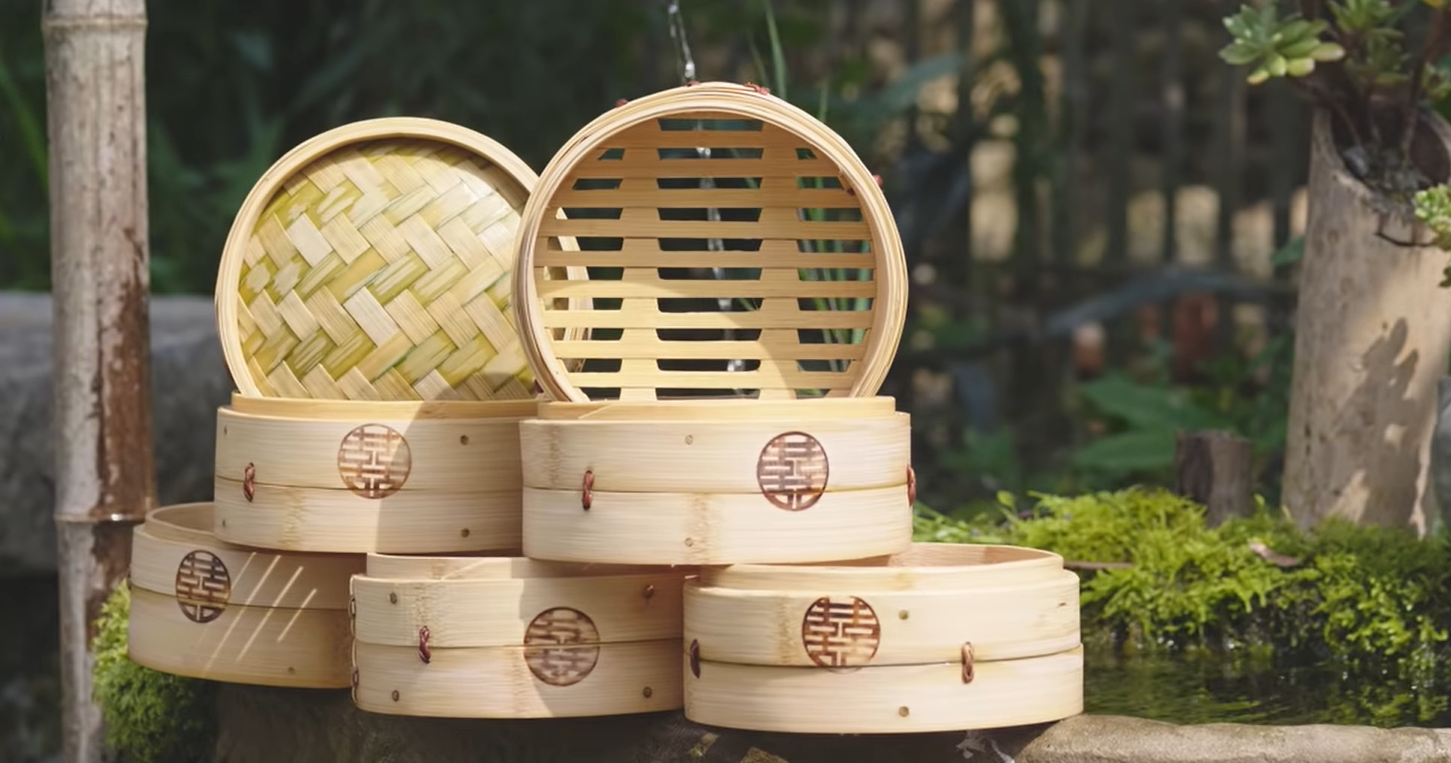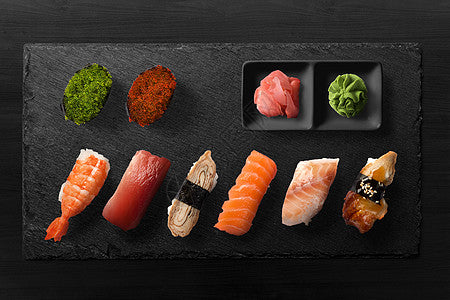What is bamboo steamer ?
A type of cookware made from bamboo consisting of individual or layered cooking pans with openings at the bottom, which are assembled and used to cook food with the use of steam. Steamers are made so that food is placed on top and not in boiling or hot water to produce steam for cooking food with moist hot air. Steaming allows food to retain its natural flavor, color, shape, and nutritional value better than when it is boiled or simmered in water. In many cases, it also improves the texture of the food. Food technicians often consider steaming the best way to preserve flavonoids, compounds found in fruits, vegetables, and some beverages (beer, wine, coffee, tea, and some fruit drinks) that can contribute and provide health benefits in fighting disease. Steamed foods can retain vitamins B and C that are lost with other cooking methods, such as braising, baking, or boiling.
A variety of cookware is commonly used for this process, such as aluminum or stainless steel single-layer steamers, stacked steamers, bamboo steamers, steamer inserts, and steamer baskets to hold food and place it over water. smoky. Pots used for steaming are covered to increase the heat and the amount of steam that is dispersed around the food.
Bamboo steamers are commonly used for smaller amounts of food and can be placed over wider steel pots of boiling water or work well over electric woks with a non-stick surface to steam foods while the wok cooks other ingredients. They are not made to be placed in an oven or microwave. Bamboo steamers allow steam to evaporate and circulate easily so it doesn't collect on the steamer lid . This type of steamer is generally best for steaming dumplings, buns, bread, or the traditional Chinese dish known as dim sum. When steaming foods made with ingredients that may stick to the surface, it is best to lightly coat the bamboo with cooking oil or vegetable oil spray. Another option is to layer a layer of leafy green vegetables, such as bok choy or other similar vegetables, to serve as a means of keeping food off the bottom of the basket and to enhance the flavor of the food. Foods that require the longest cooking time are placed on the bottom layer, which requires the least time on the top layer. While there are a variety of steamers, there are also a variety of foods that can be steamed, including cakes, bread, soups, rice, vegetables, meats, poultry, and fish.
HISTORY
The bamboo steamer originated in the Han dynasty and is a wonderful piece of Chinese food culture. Among them, the bamboo steamer is famous all over the world for its original taste, non-returning steam and color, fragrance and taste. Like ancient crafts.
There is a saying about the origin of steamers in China. In the period of Emperor Gaozu of the Han dynasty, General Han Xin used bamboo and wood to make kitchen utensils and steamer to cook food, so as to avoid smoke exposure from cooking to the barracks. Cooking dry food is easier to preserve, which is the origin of the bamboo steamer . In fact, archeology has shown that people used bamboo to make various utensils since ancient times, and steaming was the oldest recorded cooking method in the Zhou dynasty.
The old steamers are made of ceramic and bronze. The ancient kitchen mural in the Eastern Han dynasty tomb at Dahuting No.1 in Mi county, Henan province, is the earliest evidence for the origin of modern steamers.
USE
STEP 1: FILL YOUR WOK (OR OTHER PAN) WITH WATER
Place the bamboo steamer in your wok (or other wide-rimmed shallow pan, such as a wide skillet) and fill with enough water to rise above the bottom edge of the steamer by a quarter-inch to a half-inch.
The water should rise high enough to submerge the bottom edge of the steamer in water and prevent scalding. But it should also be low enough so that the bubbling water doesn't touch the bottom of the inner bed of the steamer and the food that sits on top of it.
If your bamboo steamer is new, you may want to soak the bottom edge of the steamer (which will be in direct contact with the pan) for 30 minutes or so, to make sure it doesn't burn. After using, just make sure it's completely dry before putting it away, or it may get moldy.
NOTE: A wok is the best tool to use in conjunction with a bamboo steamer because the wok is slim, making it easy to boil water and regulate water temperature, and has a wide rim that can accommodate a bamboo steamer of different sizes. That said, our most commonly used bamboo steamer size is 10 inches in diameter, and it's definitely the all-purpose size we recommend buying . If you have a large skillet that can accommodate a steamer that size, that works too!
STEP 2: ALIGN THE BAMBOO STEAMER
Once you have the water level where you want it, you can line your bamboo steamer baskets. A bamboo steamer can have many levels. Ours has 3, and we can use 1, 2, or 3 at a time, depending on how much food we have to steam.
If you are going to place food directly on the steam bed, you will need something to cover it to prevent the food from sticking to the bamboo. You can use large, soft napa cabbage leaves, lettuce leaves, layers of cheesecloth, or even squares of parchment paper. You can also use perforated parchment paper liners made specifically for bamboo steamers or, better yet, reusable cloth or silicone liners.
Anything you line the steamer with should be porous, to allow steam to rise through the bottom of the steamer and circulate around the food to cook it.
The only exception to this rule is if you're steaming marinated meats and/or vegetables, which you'll want to steam in a heatproof plate/bowl to catch any sauce or juices. If you are steaming food in a heat-resistant bowl, plate, or other container (such as the lotus leaves used in this recipe for Steamed Short Ribs with Sticky Rice), you can skip this step.

STEP 3: PLACE FOOD IN YOUR BAMBOO STEAMER
When you put meatballs, shumai, or buns in the steamer, don't overcrowd them! Note that their size will increase as they are steamed. Just like cookies on a baking sheet, they need room to expand. Always leave about 1 inch between dough balls and about 1 1/2 inches between larger buns.
If you want to steam something in a bowl or plate, it is not necessary to line the steamer. You can place the shallow heatproof bowl or dish directly in the steamer basket. Just make sure the cap still fits on top. Also, make sure there is enough open space around the plate to allow steam to rise and circulate around the food. It's also a good idea for the plate to have a rim to catch any savory sauce that may collect on the plate.
Not sure when you would use a bowl or plate to steam something? We would use it to steam vegetables like butternut squash or butternut squash to make a puree for pies, cakes, and other desserts. We also use this method for dishes like Steamed Chicken with Mushrooms.

STEP 4: PLACE BAMBOO STEAMER IN WOK/POT
Now, you can either preheat the water to a simmer when you put the bamboo steamer in the wok/pan, or you can place the steamer in the wok/pan when the water is still cold, and then turn on the heat to bring the temperature up gradually. temperature.
Unless otherwise specified, our default is the latter: place the steamer in the wok or pan when the water is cold, then turn on the heat.
NOTE: If meatballs or steamed buns have ever been frozen, they do not need to be thawed! Simply place the frozen meatballs in your steamer and begin the steaming process.

STEP 5: LET THE FOOD STEAM AND CHECK THE WATER LEVEL
Once the water in the wok/pan is boiling it will start to evaporate. Let food steam for as long as the recipe calls for, but keep an eye on it and add boiling water as needed. Be sure not to add cold water or it will stop simmering and interrupt the cooking process.
CARING FOR YOUR BAMBOO STEAMER
Again, before using a new steamer, you may want to soak the bottom layer (just the edge that comes in contact with the wok or pan) in water for 30 minutes or so, to make sure it doesn't burn or brown. burn. After using, just make sure it's completely dry before putting it away, or it may get moldy.
To clean your bamboo steamer, wash it with a sponge and mild dish soap, and immediately rinse thoroughly.
Let the steamer air dry for at least 2 days before storing to prevent mold growth.
Do not put your bamboo steamer in the dishwasher. Do not soak it in water in the sink for more than 5 minutes.
We hope this article has shed some light on how to use a bamboo steamer and why it is such a useful cooking tool in an Asian (or any other) kitchen.





Leave a comment
All comments are moderated before being published.
This site is protected by hCaptcha and the hCaptcha Privacy Policy and Terms of Service apply.